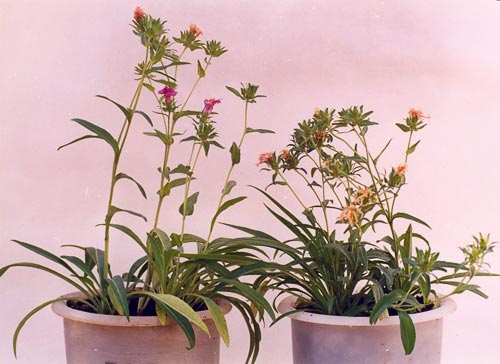Relatives
Carthamus oxyacanthus Bieb. - Sharp-thorn safflower.
Taxonomic position.
Family: Asteraceae Dumort.; genus: Carthamus L.Morphology and biology.
Annual plant up to 70 cm high. Stem is straight, rather hard, with divaricate ramification from the middle or higher, smooth, of whitish colour, naked below, but downy closer to the top. Leaves are sessile, slightly amplexicaul, rather rigid, with protruding veins; their shape is oblong or oval, dentate along the edge, with straw-yellow thin thorns equal in size to the width of leaves, spiky at the tip, naked or (especially topmost ones) with greyish pubescence; lower ones are often pinnately parted. Anthodia are congested, 2.5 cm in length and 1.5 cm in diameter. Outer leaflets of the involucel are whitish below and phylloid in the upper part, with long light-yellow thorns, equal in length to the flowers. Inner leaflets of the involucel are scarious, lanceolate, whole, spiky on the tip. Sometimes the leaflets of the involucel are cobwebby (C. oxycanthus var. arachnoideus Bge.). Flowers are light-yellow. Achenes are obovate-tetrahedral, truncated at the top, smooth, a little glossy, light-yellow, spotted black, up to 6 mm long. Pappus is absent in most cases but, if present, its bristles are few, shortly or finely serrate and ciliate, unequal in length, and longer than the achene. Blossoms in June; bears fruit in August. Entomophilous. Zoochore.Distribution.
General distribution: Armenian-Kurdish region and Iran. Within the ex-USSR territory: Caucasus (Eastern Ante-Caucasus and Eastern Transcaucasia) and Central Asia (Tien Shan, Pamir-Altai and Mountainous Turkmenia).Ecology.
On sandy places, in the field, and as a weed.Utilization and economic value.
Used in breeding practice to improve the varieties of bastard saffron (C. tinctorius L.). Capable of hybridization with other species of this genus. Natural hybrid C. oxycanthus MB. x C. tinctorius L. was described in 1939 by Popova. The hybrid with another species - C. lanatus L. x C. oxycanthus Bieb. = C. turkestanicus M. Pop. - was described in 1941.References:
Cherepanov, S.K. 1995. Plantae Vasculares Rossicae et Civitatum Collimitanearum (in limicis USSR olim). St-Petersburg, "Mir I Semia", 990 p. (in Russian).Flora USSR, 1963. Vol. 28. E.G. Bobrov, S.K.Cherepanov (ed.) M.-L.: Publishing House of Acad. Science, pp. 583-584. (in Russian).
Nikitin, V.V., Geldihanov A.M. 1988. The Manual of plants of Turkmenistan. L.: Nauka, p. 635.
Wulf, V.V., Maleeva, O.F. 1969. The World Resources of the Useful Plants. Leningrad: Nauka, pp. 427-428. (in Russian).


